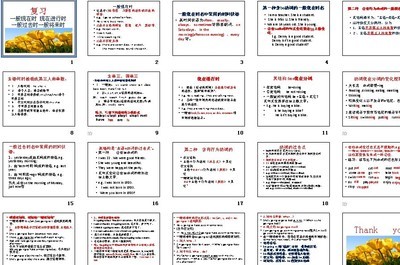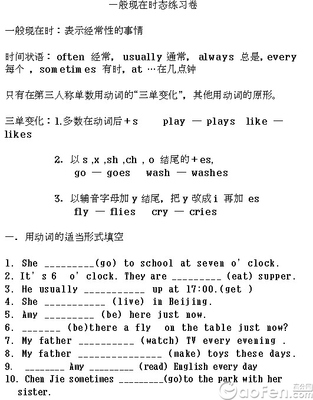语态(Voice),作为一个语法范畴,是表示主语和动词之间的主动或被动关系的动词行式。英语动词有两种语态:主动语态(Active Voice)和被动语态(Passive Voice)。当主语为动作执行者即施动者时,动词用主动态;如果主语是动作的承受者即受动者时,动词便用被动态。例如:
(1) John helped Peter.
(2) Peter was helped by John.
句(1) helped是主动态;句(2)was helped是被动态,可见主动态是无标记的,而被动态是有标记的。
构成
被动语态由助动词be的时态之一和及物动词的过去分词构成。被动语态可用于各种时态,其时态变化通过助动词be的不同形式来体现。如:一般现在时的被动态构成形式为助动词am/is/are + 过去分词;而一般过去时的被动态构成形式为was/were + 过去分词。本册要掌握的被动语态形式有:
一般现在时:am/is/are + 过去分词
e.g. Football is played all over the world.
I’m often asked to do this work.
我常常被派做这项工作。
一般过去时:was/were +过去分词
e.g. The terracotta warriors were found in 1974 near Xi’an.
They were discovered by workers in a field outside the city.
When was the building completed?
这座大楼什么时候建成的?
一般将来时:will (shall) + be +过去分词
be going to + be + 过去分词
e.g. The result of the exam will be known soon.
They are going to be given a difficult test.
一般过去将来时:should(would) be+过去分词
e.g. The teacher said the results would be published soon.
He told me that the film would be shown the next week.
现在进行时:am/is/are + being +过去分词
e.g. The new airport is being built by a foreign company.
一家外国公司正在承建这座新机场。
The song is being sung by the girls now.
过去进行时:was/were being+过去分词
e.g. The song was being sung by the girls when I got there.
The student was being criticized when I went into the
teacher’s office.
将来完成时:will have been+过去分词
e.g. By the end of next term 2000 English words will
have been learned.
The building will have been built by next year.
现在完成时:has/have + bee n +过去分词
e.g. All the tickets have been sold .
The book has been translated into many languages.
这本书已被译成多种语言。
过去完成时:had been+过去分词
e.g. Forty schools had been visited by last year.
All the tickets had been sold out when I got to the cinema.
过去将来完成时:would have been+过去分词
e.g. He said many words would have been learned by 2001.
They promised that ten books would have been published
by the next month.
情态动词:情态动词 + be + 过去分词
e.g. This road must be mended.
The machine parts may be needed in our work.
工作中可能需要这些机器零部件。
动词不定式:to be + 过去分词
e.g. I’m glad to be asked questions.
It is impossible for lost time to be made up.
失去的时间不可弥补。
主要用法
被动态常用于下列几种场合:
1.当不知道或不必提出动作的执行者时(这时都不带由by引起的短语);
Printing was introduced into Europe from China.
印刷术是从中国引入欧洲的。
The airplane was made in U.S.
Such books are written for children. 这种书是为儿童写的。
2. 动作的承受者是谈话的中心(这时可带有由by引起的短语);
The song was composed by a student.
这首歌曲是一个学生谱写的。
Thousands of rivers are polluted in the country.
3. 出于礼貌措词等原因而不愿说出动作执行者是谁。
You are requested to get here in time.
请您准时来这儿。
带行为主体的被动态
行为主体就是动作的执行者,即执行动词所表达的动作的人或物。在被动句中,往往不提及行为主体;但当强调动作的执行者时,可用介词by引出行为( by +主体行为主体),置于被动态句的末尾,说明是什么人或物应对有关事件负责。
类别:通向语法街 | | 添加到搜藏 | 分享到i贴吧 | 浏览(31) | 评论(0)
上一篇:关于“目标”的名言下一篇:被动语态2
相关文章:
• 被动语态四 • 被动语态三
• 2011年职称英语考前通关训练:被... • 初中英语被动语态的用法小结
• 英语小检测--语法被动语态! • 被动语态练习题(各类形式齐全)
• 二,被动语态 • 考研英语翻译:被动语态的翻译
• having done 是主动语态 done是... • 直接引语间接引语的记忆口诀,定...
更多>>
被动语态2
2009年07月30日 星期四 03:11 P.M.
e village was destroyed by a bomb.
这个村庄毁于炸弹。
The painting is very valuable. It was painted by Van Gogh.
这幅画很值钱,它是梵·高画的。
其它用法补充
1.“It + 被动语态+ that 从句”。表示谨慎或不太肯定的语气。常用于该结构的动词有:say, think, believe, agree, expect, consider, feel, know, decide, report, suggest, prove 等。
e.g. It is said that prices will rise again this month.
据说本月物价还将上涨。
It is thought that about a million dogs are born each year.
据认为每年约有一百条狗出生。
It is reported that all the passengers died in the crash.
据报导所有乘客在那次飞机坠毁中遇难。
It is agreed that we will have two weeks holiday this year.
2. 用于通告标题广告等的被动态往往省去助动词be。
e.g. No Chinese spoken here.
Shoes repaired.
Famous Painting Stolen. 名画被盗。
类别:通向语法街 | | 添加到搜藏 | 分享到i贴吧 | 浏览(19) | 评论(0)
上一篇:被动语态下一篇:非谓语动词
被动语态三
2010-12-19 22:28
K.不能变为被动语态的结构
1.受动词的限制
①表示状态的及物动词,只能用于主动语态。
某些表示状态的及物动词,如have, own, cost, lack, want (缺乏), become (适合), fit, resemble, fail, last, flee, benefit, hold等作谓语时,不能变为被动句。
She resembles her mother. 她像她妈妈。
He lacks self-confidence. 他缺乏自信。
This hall can hold 2,000 people. 这个大厅能容纳两千人。
②当及物动词have表示“吃饭”、“患病”、“明白”、“知道”等意思时,没有被动语态形式。
Would you have a cup of tea 你要喝杯茶吗?
She had a bad cold yesterday, and now she is feeling much better. 昨天她得了重感冒,现在好多了。
③当动词get,take表示“懂得”、“知道”,owe表示“欠”,cost表示“使失去(生命、健康等)”的意思时,动词没有相应的被动语态。
Do you get me 你明白我的意思吗?
How do you take this passage 这段话你怎么理解?
I owe 50 pounds to you. 我欠你五十英镑。
His careless driving cost his life. 他粗心的驾驶使他丧了命。
2.受宾语的限制
①当宾语是相互代词、反身代词或具有类似相互代词的关系时,动词不能用于被动语态形式。
They simply cannot contain themselves for joy. 他们简直无法抑制内心的喜悦。
He absented himself from a meeting yesterday. 他昨天缺席会议了。
For years the two sisters looked after one another. 多年来两姐妹互相照顾。
②当宾语前带有主语的形容词性物主代词时,谓语动词通常不能转换为被动语态。
I could not believe my eyes when I saw him still alive. 看到他还活着,我简直不相信自己的眼睛。
The doctor shook his head and then went out without any words. 医生摇了摇头,一句话也没说就出去了。
注意:
动词的宾语是身体的一部分,一般不可变为被动语态,但也有例外。
He fixed his eyes on the oil painting. 他注视着这幅油画。
-- His eyes were fixed on the oil painting. 他的两眼注视着这幅油画。
③当宾语起状语作用,表示数量、重量、大小或程度时,不能用被动语态。
This kind of dictionary costs ten dollars. 这种字典价值十美元。
The case weighs twenty kilos. 这箱子重二十公斤。
④当宾语是同源宾语时,通常不能转换成被动语态。
He laughed a hearty laugh. 他由衷地笑了笑。
She dreamt a sweet dream. 她做了一个美梦。
⑤如果宾语是动词不定式或动词的-ing形式时,谓语动词一般不能变换成被动语态。
He admitted having done wrong. 他承认做错了。
He has decided to go and study abroad. 他已决定出国留学。
⑥如果enter, leave, reach的宾语是地点、国家机关等,不能改为被动语态
He left the army in 1998. 他1998年退伍。
She entered the hall at once. 她立刻就进入了大厅。
⑦另外,不可拆开的短语动词,如take place, lose heart, belong to, consist of, change colour等,也不能改为被动语态。
The book belongs to me. 这本书是我的。
She caught a very bad cold. 她患了重感冒。
<?xml:namespace prefix = o ns = "urn:schemas-microsoft-com:office:office" />
p;必背:一些常见的不能变为被动语态的动宾词组
catch a cold 感冒
eat one's words 食言
lose heart 丧失信心
lose patience 失去耐心
make a face 做鬼脸
make up one's mind 决心
make bed 铺床
make room for 为……腾出地方
keep watch 守望

keep silence 保持安静
speak one's mind 表明见解
take place 发生
take one's time 从容不迫,别着急
take office 就职
take one's leave 请假
take notes 作笔记
take up arms 拿起武器
take one's place 就位
⑧含有would rather或情态动词dare的句子,不能改为被动语态。
I would rather do it now. 我宁可现在就干这件事。
He dare not do it. 他不敢干那件事。
类别:语法 | | 添加到搜藏 | 分享到i贴吧 | 浏览(29) | 评论(0)
上一篇:被动语态二下一篇:被动语态四
相关文章:
• 2011年职称英语考前通关训练:被... • 初中英语被动语态的用法小结
• 英语小检测--语法被动语态! • 被动语态练习题(各类形式齐全)
• 二,被动语态 • 考研英语翻译:被动语态的翻译
• having done 是主动语态 done是... • 直接引语间接引语的记忆口诀,定...
• 被动语态 习题3 • 被动语态 习题2
更多>>
被动语态四
2010-12-19 22:28
四、被动语态与系表结构
所谓系表结构,在此指“连系动词+用作表语的动词-ed形式”结构。它与被动语态的形式完全一样,所以在应用时应注意它们的区别。
A. 被动语态中的过去分词是动词,多强调动作;系表结构中的过去分词相当于形容词,多强调状态。前者通常可用by+人或by+抽象名词表动作的执行者,而后者则一般不用。
The gate to the garden was locked by the girl. 花园门被那个女孩锁上了。(被动结构)
The gate to the garden was locked. 花园门锁了。(系表结构)
The tree was blown down by the high winds. 那棵树被大风吹倒了。(被动结构)
The tree was blown down when we saw it. 我们看到那棵树时,它已经被吹倒了。(系表结构)
注意:
少数“连系动词be + 用作表语的动词-ed形式”也带by短语。
The old man was surrounded by small children. 老人被孩子们团团围住。(被动语态)
<?xml:namespace prefix = st1 ns = "urn:schemas-microsoft-com:office:smarttags" />Guilin is surrounded by hills and mountains. 桂林周围都是山。(系表结构)
We were held up by fog. 我们因雾受阻。(被动语态)
The tree is known by its fruit. 看到果子就知道是什么树。(系表结构)
B. 系表结构一般只用于一般现在时、一般过去时等少数几种时态;而被动语态可用多种时态。
The composition is well written. 这篇作文写得很好。(系表结构)
The composition is being written. 这篇作文正在写。(被动语态)
C. 系表结构中的过去分词可被very, too, so修饰,被动语态中的过去分词须用much修饰。
The boy was too frightened to move. 这孩子吓得动也不敢动。(系表结构)
He was very excited.他很激动。(系表结构)
He was much excited by the news. 他听到消息后很激动。(被动结构)
D. be + 不及物动词的过去分词通常是系表结构。
Her money is all gone. 她的钱都花光了。
The honoured guests are arrived. 贵宾们到了。
The moon is risen. 月亮升起来了。
She is grown up. 她长大了。
The leaves are fallen. 树叶落了。
We are prepared for the worst. 我们已准备好应付最坏的情况。
E. 表示“充满”意思的“be + 过去分词 + with”结构多为系表结构。
The mountain is covered with snow all the year round. 这座山终年被积雪覆盖。
The classroom was crowded with pupils. 教室里挤满了学生。
The lake is dotted with fishing boats. 湖里渔帆点点。
The floor was piled with old books. 地板上堆满了旧书。
F. remain, feel, lie, stand 以及 become, grow 等词 + 过去分词结构多为系表结构。
The matter remained unsettled. 这件事悬而未决。
She felt disappointed. 她感到失望。
The road became crowded. 道路拥挤了。
G. 句中有时间状语和地点状语时,一般为被动语态,反之为系表结构。
The bank is closed. 银行现在关门了。(系表结构)
The bank is usually closed at six. 银行通常六点关门。(被动语态)
He is married. 他结婚了。(系表结构)
He was married in Beijing. 他是在北京结婚的。(被动语态
类别:语法 | | 添加到搜藏 | 分享到i贴吧 | 浏览(28) | 评论(0)
上一篇:被动语态三
相关文章:
• 同学们必须看并理解记忆有关被动... • 2011年职称英语考前通关训练:被...
• 初中英语被动语态的用法小结 • 英语小检测--语法被动语态!
• 被动语态练习题(各类形式齐全) • 二,被动语态
• 考研英语翻译:被动语态的翻译 • having done 是主动语态 done是...
• 直接引语间接引语的记忆口诀,定... • 被动语态 习题3
更多>>
 爱华网
爱华网

